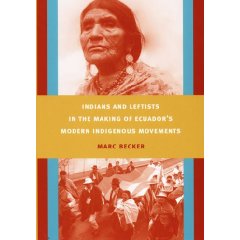
| The Book |
| Chronology |
| Acronyms |
| Glossary |
| Biographies |
| Revolts |
| Documents |
| Data |
This is an Electronic Appendix of documents to accompany my book Indians and Leftists in the Making of Ecuador’s Modern Indigenous Movements (Duke University Press, 2008).

The Americas 66, no. 1 (July 2009), 124-25
Indians and Leftists in the Making of Ecuador's Modern Indigenous Movements. By Marc Becker. Durham: Duke University Press, 2008. Pp. xxv, 303. Chronology. Acronyms. Illustrations. Notes. Biographies. Bibliography. Index. $79.95 cloth; $22.95 paper.
While there has been significant literature produced about Ecuador's indigenous movements since they burst onto the national political scene during the powerful and both highlycoordinated and fundamentally grass-roots 1990 indigenous uprising, we still know relatively little about the deeper historical roots of these movements. Becker's book is therefore all the more welcome, as it tells a new story in which the indigenous movement of the 1990s is understood not as a new phenomenon, but rather as the culmination of decades of organizing efforts involving collaboration among urban leftists and indigenous activists, whose interaction transformed the understandings and strategies of both sides of this equation.
This book covers considerable historical terrain, from the founding of the first local agricultural syndicates on highland haciendas in the 1920s, to rural strike activity in the 1930s, as well as the attempts to establish the Federaci—n Ecuatoriana de Indios (successful in 1944) and its subsequent history, to the rural struggles underlying the passage of agrarian reform legislation in the 1960s and 1970s, and the emergence of a strong and integrated indigenous movement in the 1980s and 1990s that increasingly played an important role in national political debate. The historical analysis is grounded in a significant amount of new documentation, covering such issues as specific peasant struggles on haciendas (including accounts of the actions of both peasant and urban activists), the leadership trajectory of a number of indigenous peasant activists, internal debates within the Ecuadorian left, the formation of a left public sphere through the production and circulation of various newspapers and other media, and more. All of this is set against a backdrop of national political history, and in some cases, we are shown for the first time how these militant incidents and organizational processes had a direct impact on that history, as well as being influenced by it. Throughout the narrative, Becker demonstrates how the threads of gender, ethnicity, and class were interwoven in these historical processes, as they are, too, in his analysis.
The main question that I was left with at the end of this book is the following: if we accept that some urban leftists in Ecuador from the 1920s on were open to collaborative, rather than merely paternalistic, relations with indigenous peasant activists, how can we explain this? It is not at all obvious, given the nature of Ecuadorian social relations, status hierarchies, and racial ideologies almost a century ago (or even much more recently), that urban activists would be disposed to work together on an equal footing with peasants of any kind, much less indigenous ones. What was it in the experience of this generation of urban leftists that led them to this unlikely alliance? What was the social profile, rather than just individual identity, of these urban activists that led them not only to the left, but to cooperating in a relatively democratic way with people from such a different background? Answering these questions would admittedly require a rather different research project. One of the merits of Becker's book, then, is that it opens up new research questions by establishing, I think quite persuasively, that there is indeed evidence of collaborative relations among members of these two very different social groups, who through their interactions forged a novel vision of a possible future, and together developed strategies to try to attain it.
The text of Becker's work is enhanced by many evocative photographs, including both those taken by the author and contemporary images drawn from Ecuadorian archives. In addition to its interest for colleagues who research indigenous or other social movements, in Ecuador or elsewhere, this book is written in an accessible way that will make it useful for teaching undergraduate as well as graduate students.
A. KIM CLARK
University of Western Ontario
London, Ontario